From Ohio to Egypt, These Are the 14 Scariest Cemeteries in the World — Visit Them if You Dare
Prepare for the heebie-jeebies.
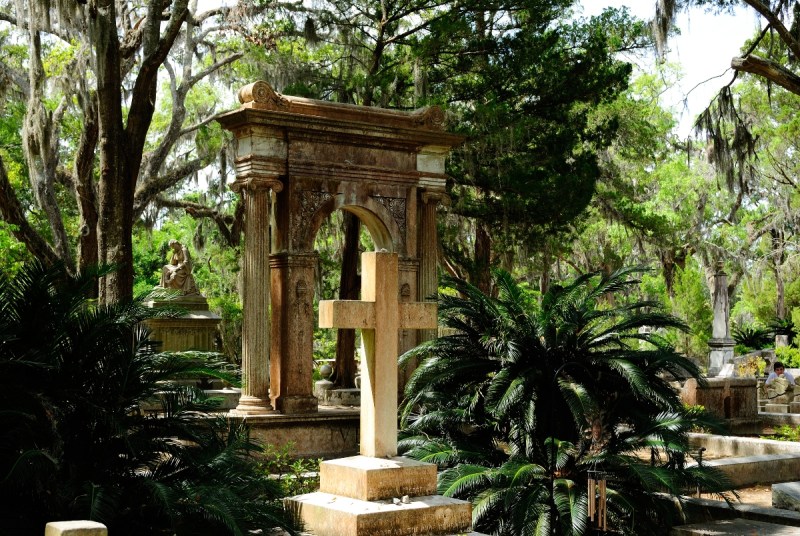
Cemeteries aren’t typically happy places. Reflective — and even comforting — sure; but with the ghost story lore of hundred-year-old curses, tragic deaths, angry spirits, and unique burial rituals, even the most beautiful cemeteries can give you the heebie-jeebies. Do the dearly departed rest in peace, or do their spirits haunt the grounds of the graveyards where they lay? If you answered the latter, you’re not alone in your belief. Folklore and spooky tales of frightening cemetery encounters exist the world over. Below are 14 of these bone-chilling spots.
Valley of the Kings (Egypt)
If the curse of King Tut doesn’t get you, the phantom pharaoh on a fiery chariot drawn by menacing black horses, or the bloodcurdling screams, will.
Deep in the Theban Hills, off the western Nile, is the Valley of the Dead. This spooky spot operated as a burial site for Egyptian pharaohs and nobility for almost 500 years, from the 16th to 11th century B.C. It comprises two huge valleys, and includes the Valley of the Kings, Valley of the Queens, Habou Temple, the Colossi of Memnon, and the Temple of Hatshepsut.
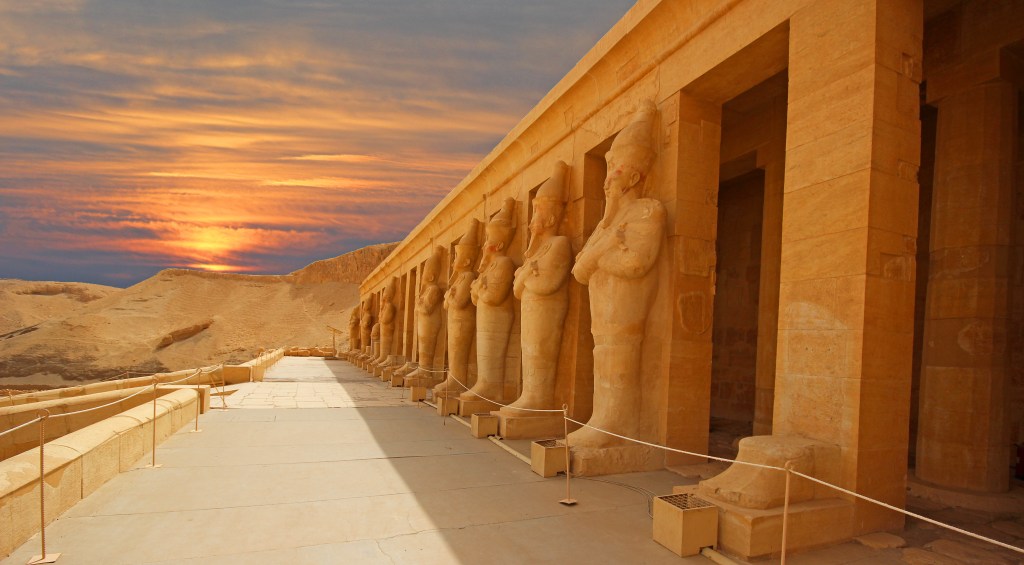
Inside the ancient Egyptian burial site, then called Thebes but now known as Luxor, there are 63 known tombs and chambers crafted for important noblemen and mighty pharaohs, including Seti I and Ramesses II. Legend has it that disturbing the embalmed remains of the royals will bring bad luck, extreme illness, and even death. That being said, these intricate underground vaults, which were filled with treasures for the dead to use and enjoy in the afterlife, were never intended for anyone else to see, let alone enter.
The Curse of King Tut: Fact or Fiction?
The tomb of the young pharaoh Tutankhamun, commonly called King Tut, was discovered by archaeologist Howard Carter in 1922. A few days later, a cobra — a symbol of the pharaohs — killed his pet bird. Six weeks later, his chief financial backer, Lord Carnarvon, died at the age of 56 from an infected mosquito bite. Author Sir Arthur Conan Doyle, creator of Sherlock Holmes, suggested that the lord’s death was caused by “elementals” in the tomb. This comment and newspaper reports strengthened the belief that there is an ancient curse attached to the tombs of the pharaohs.
Others in Carter’s archaeology crew died within a few years of King Tut’s discovery. His secretary was smothered in bed while he slept. Carter dismissed the mummy’s curse as “tommy-rot,” but on the day he died in England in 1939, all of the lights in Cairo went out. Was it a weird coincidence or the curse of King Tut? We will never know, but an apparition of a man wearing early 20th-century garb, who many believe to be Carter, has been seen frantically searching for something around the Great Pyramid of Giza. That is the final resting place of the Fourth Dynasty Egyptian pharaoh Khufu, though it is anything but peaceful. The ghost of Khufu himself fearlessly approaches tourists to warn them and demand that they leave his pyramid in peace.
The Phantom Pharaoh
King Tut may be the most famous of the pharaohs laid to rest at the Valley of the Kings, but a royal spirit seen riding a fiery golden chariot powered by black horses at midnight makes his presence known to some of the 10,000 visitors that tour the site every day. Eyewitnesses describe the phantom pharaoh as being a man, small in stature, dressed in full royal attire, complete with a golden collar and headdress. According to Egyptian mythology, the pharaoh Akhenaten, who banned the worship of gods in the 14th century B.C., has been cursed to wander the deserts for eternity as punishment. Eyewitnesses insist they’ve seen his spirit striding around the sandy site.
Several watchmen tell tales of hearing anguished cries full of rage and loathing echoing across the empty desert at night. They also report being followed by disembodied footsteps and the clanging of chariot wheels, as if speeding specters are racing through the valley in the dead of night.
These guards have begged for someone who understands hieroglyphics to visit the Valley of the Kings and appease the angry ghosts by letting them know that their mummies and treasured belongings are safely protected at places such as the Cairo Museum. Still, an official at the Antiquities Department claimed their request was “too grotesque to be investigated.” And so, the anguished royals continue to wail woefully across this great desert land.
Bonaventure Cemetery (Georgia)
A ghastly little girl cries bloody tears and the statues come alive in this spine-chilling Southern burial garden.
Visitors to the Bonaventure Cemetery often have the feeling that someone is watching them. And they might be right — the Savannah, Georgia, graveyard is a 100-acre playground for spirited souls. Even the mysterious stone statues that stand watch over their graves appear to move. Passing through the main gate is like stepping back in time. The trees — massive, towering oaks draped in Spanish moss like spider-webs — have an otherworldly quality.
The graveyard is home to many famous figures. This includes Savannah-born Grammy award-winning “Moon River” songwriter, Johnny Mercer, and one-time American poet laureate Conrad Aiken. Yet, some of the cemetery’s most famous residents weren’t buried there. The statues in Bonaventure are known to move around and even smile or sneer at visitors. The sculpture of Corinne Lawton, who is said to have died by suicide after being jilted by the man she loved, gets the biggest reaction from guests. Some claim she smiles at the happiest of observers. At more miserable visitors to her final resting place, she will scowl in disgust.
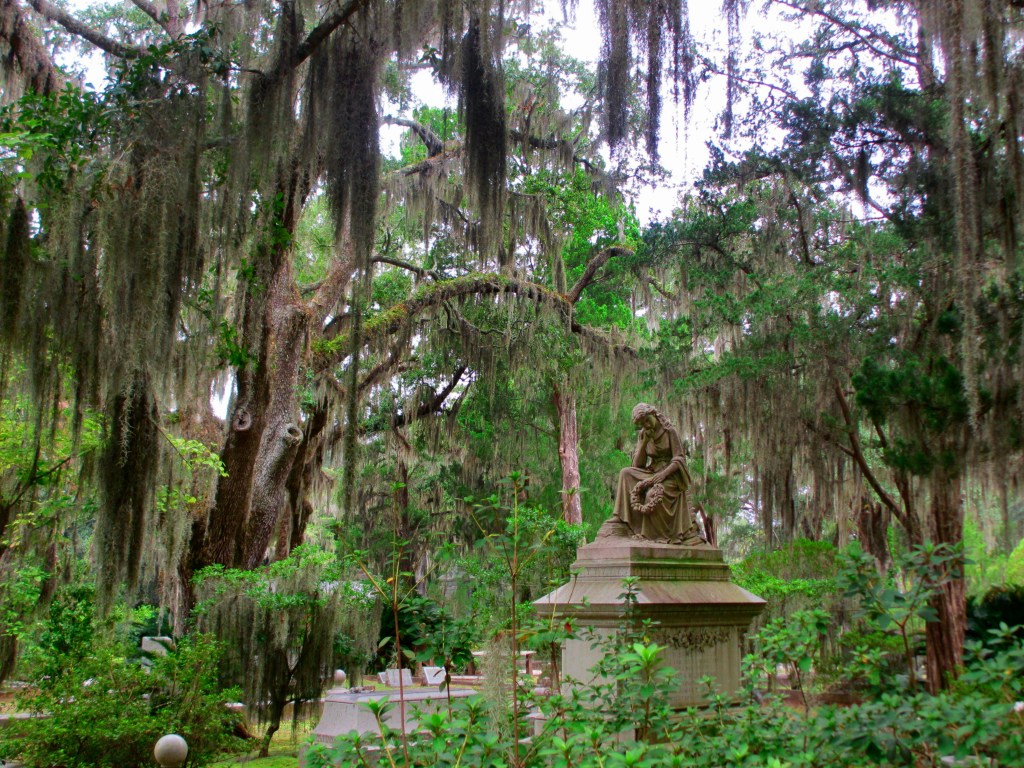
Bird Girl
“We are confident, then, and would prefer to be away from the body and at home with the Lord,” reads the inscription on the cemetery’s Bird Girl statue. But, according to local lore, Lorraine Greenman, a young girl who posed for the sculpture by Sylvia Shaw Judson, haunts the figure. That sculpture, which stood watch over the Trosdal family plot, gained popularity when it appeared on the cover of John Berendt’s 1994 novel, Midnight in the Garden of Good and Evil, and subsequently was featured in the 1997 film adaptation. It has since been moved to the Telfair Academy Museum to save Little Wendy, as it is also called, from natural and human destruction.
Little Gracie
Then there’s the marble statue, Little Gracie, that artist John Walz crafted to memorialize Gracie Watson. It’s believed that the young girl fell victim to pneumonia in 1889 at the age of 6, just two days before Easter Sunday. For decades, people have reported seeing the girl in a white dress playing around Johnson Square in downtown Savannah. This is where Gracie’s father, Wales, once managed the Pulaski House hotel.
Eyewitnesses turn pale when they talk about how she likes to mysteriously vanish into thin air when someone gets too close to her. If you visit the site, be sure to bring Little Gracie a gift to keep her on your good side. She is said to cry tears of blood when her toys are taken away. If that’s not terrifying enough to give you chills, some visitors report hearing the wailing cries of a baby coming from an infant’s grave.
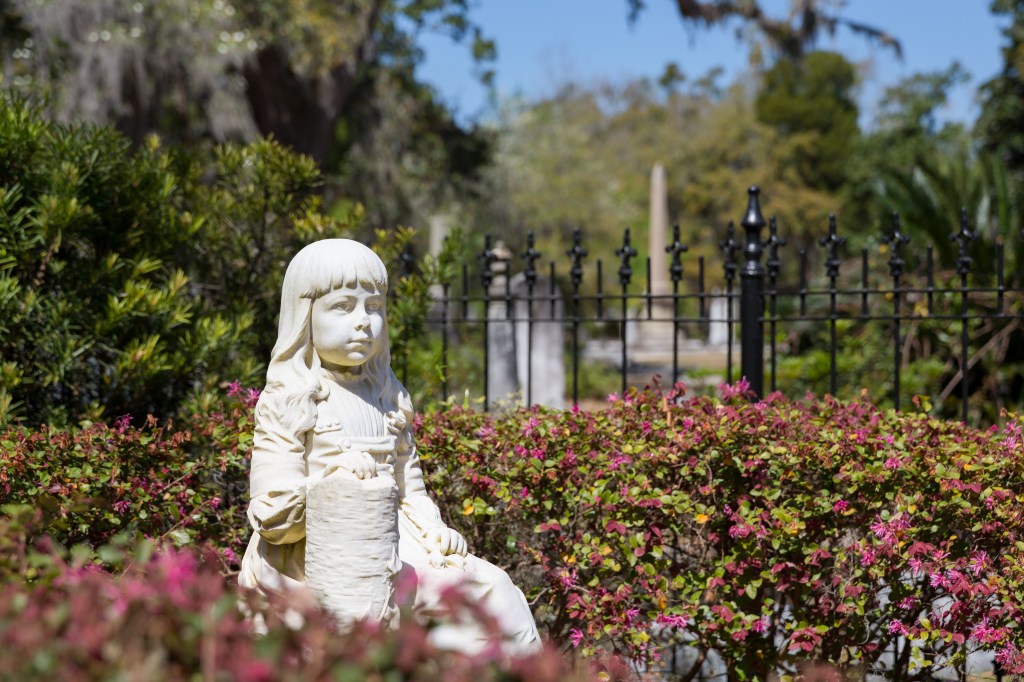
La Recoleta Cemetery (Argentina)
It’s famous for being the final resting place of Eva Perón, but it’s another woman whose ghost haunts the graveyard.
It’s hailed as one of the most beautiful cemeteries in the world. However, it’s also the location of one of the most frightening deaths. Built in 1822, La Recoleta is the resting place of Eva Perón, aka Evita, the former first lady of Argentina. Tourists flock to the Buenos Aires cemetery to stroll among more than 6,000 graves and towering, ornate mausoleums of the rich and famous. But, they also come to pay tribute to a beautiful young woman whose death is the stuff of nightmares.
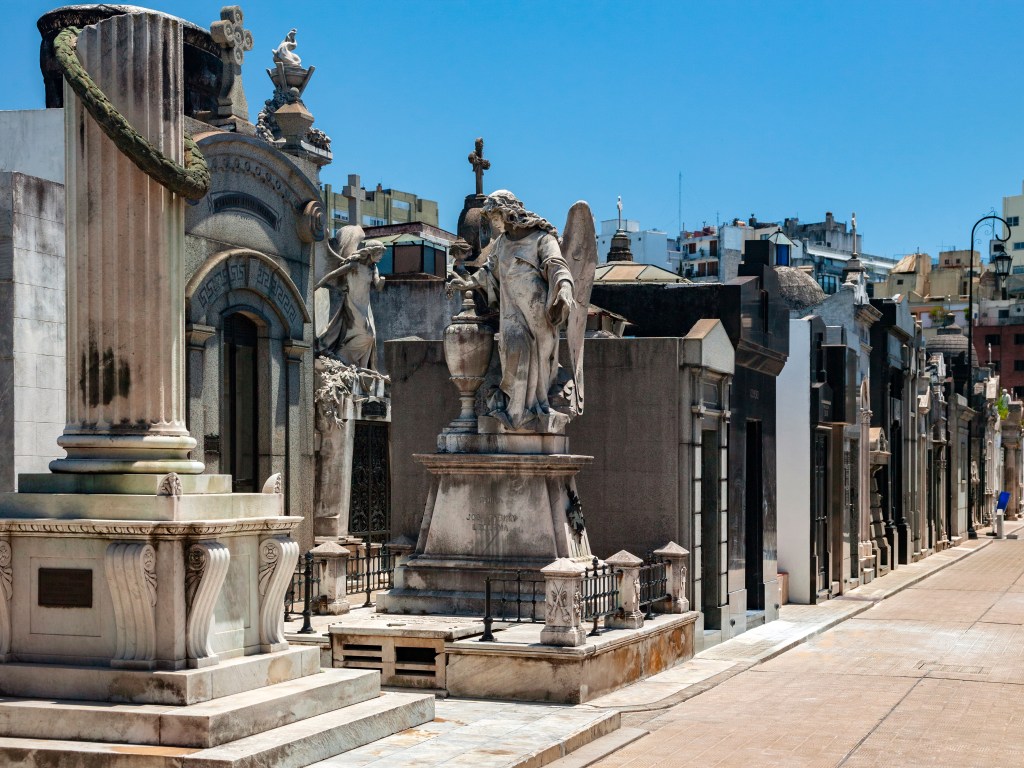
In 1902, Rufina Cambacérès was accidentally buried alive when a strange illness rendered her unconscious on her 19th birthday. After three doctors pronounced her dead of a heart attack, she was put in a coffin and placed in the family vault. After the funeral, cemetery workers reported hearing a woman’s screams. Days later, they discovered her disturbed tomb, with the coffin moved and the lid broken.
Opening the coffin, they found scratch marks where she had frantically clawed at the inside to free herself. This time, Cambacérès was truly dead, likely from a heart attack due to panic and a lack of air. Her hands and face were bruised from her exertions. Now known as the girl who died twice, she was laid to rest again. A life-size statue was placed outside her mausoleum, her hand resting on the door to the tomb. Ever since that tragic incident, the ghost of the sad birthday girl has been spotted by visitors to La Recoleta.
A Loyal Employee
Cambacérès is not the only spirit who roams the graveyard. Tourists have also seen a mysterious woman in white wandering the narrow alleyways. The cemetery’s longtime caretaker, David Alleno, also clocks in from the spirit side. Alleno saved his pay and commissioned a customized crypt at his beloved workplace. He travelled to Italy to have an artist craft a statue in his likeness. It was even complete with a watering can, broom, and keys. Alleno took his own life in 1910, shortly after the burial plot was finished. Today, clanking keys can be heard around the ghostly grounds — a sign that Alleno is still making his rounds.
La Noria Cemetery (Chile)
The locals have a warning: Don’t visit the graves at night. That’s when the zombies arise.
Like any ghost town, the ruins of the old mining village of La Noria in the north of Chile are eerie and unsettling. Founded in 1826, the desert town was built on the backs of the workers who spent long hours extracting saltpeter — an essential ingredient in fertilizer and a food preservative — from the Atacama Desert. However, the discovery of synthetic saltpeter in Germany during World War II put the final nail in the coffin of La Noria. The mine shut down, and soon after, the city was abandoned. Or was it?

Locals from nearby towns, like Iquique on the Pacific coast, don’t dare go to La Noria at night. They warn that zombies emerge from the creepy cemetery on the outskirts of the town after sundown. A collection of crosses mark the forgotten dead of La Noria. Their shallow graves have been open to the elements, with wood coffins rotten and broken apart, revealing the skeletal remains of the deceased. Some say looters disturbed the graves. Others suggest the hot sun and desert winds uncovered the bones. Locals, however, insist something much more sinister is to blame.
Keep Out
People report hearing footsteps, screams, and disembodied voices. These are believed to be the ghosts of the miners who worked in inhumane conditions. Many, including children, died horribly due to their poor living conditions. Eyewitnesses claim phantom children creep around the dilapidated schools after sundown. At the same time, shadowy figures and apparitions have been spotted wandering the ruins of their former home.
In 2003, a man discovered a strange 6-inch skeleton with a conical skull, wrapped up and marked with purple ribbon. Images of the tiny being ignited rumors of aliens. It quickly became known as the “Atacama humanoid,” until a DNA test determined in 2018 that it was a human girl with dwarfism. Locals claim that visitors to La Noria have gone missing, which is why people from neighboring towns often try to stop tourists from venturing to the haunted ghost town.
Pére Lachaise (France)
A former French president’s evil entity and a lovesick phantom poet give guests goose bumps at this site in the City of Light.
More than 3.5 million people visit the Père Lachaise cemetery, located on the northeast side of Paris, annually. Not all of them are alive. The cemetery spans 110 acres, and an estimated 300,000 to 1 million people are buried at this Gothic graveyard, from paupers to politicians and celebrities.
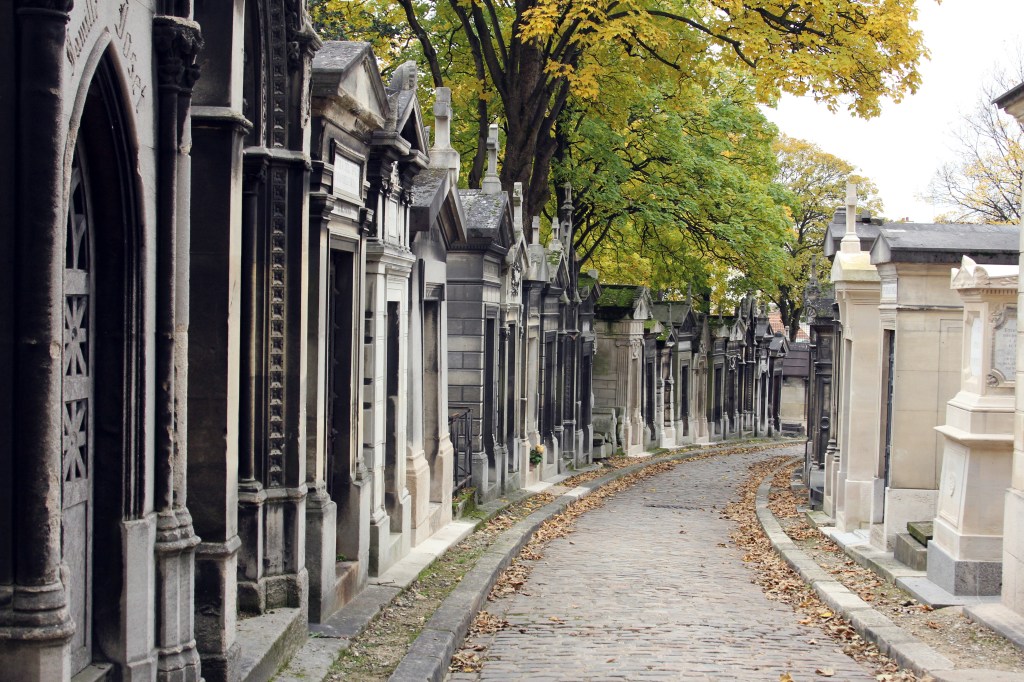
It is the eternal resting place of world-renowned singer Edith Piaf, as well as Jim Morrison, lead singer of ’60s rock band, The Doors. Since his death in 1971, there have been countless sightings of the Lizard King’s ghost pacing around his plot. To this day, the site still draws standing-room-only crowds. He is even said to appear as an apparition in a photo that shows rock historian Brett Meisner standing beside the singer’s grave in 1997.
Morrison isn’t the only otherworldly artist haunting the historical site. Legend has it renowned author Marcel Proust arises from his grave every night on an eternal quest to find his lost lover, Maurice Ravel. Ravel was, against their wishes, laid to rest in a different cemetery. Composer Frédéric Chopin was so scared of being buried alive that he insisted his body be laid to rest in Paris, while his heart was buried in Poland. Visitors have seen colored orbs floating near his grave.
Not all of the ghosts at Père Lachaise are harmless. Adolphe Thiers, a 19th-century historian and the second elected president of France, has a sinister way of protecting his final resting place. Rumor has it Thiers gets handsy with those who dare pass by his mausoleum. Visitors claim their clothing has been pulled, as if by phantom hands.
Trunyan Cemetery (Indonesia)
Hundreds of rotting corpses on full display earn this place the nickname Skull Island.
Most Balinese Hindus cremate their dead. However, in Kintamani in northeast Bali, Indonesia, there is an isolated village community on the far side of Lake Batur that deals with their dead in an entirely different, bone-chilling way. In this petrifying part of the world, the dearly departed have been decomposing aboveground for centuries. The Trunyanese villagers, known as the Bali Aga, set their dead sailing in canoes to decay, or they wash the deceased body before dressing it and placing it inside a bamboo cage to protect it from wild monkeys and other island animals while it decomposes in the open air at the base of a banyan tree.
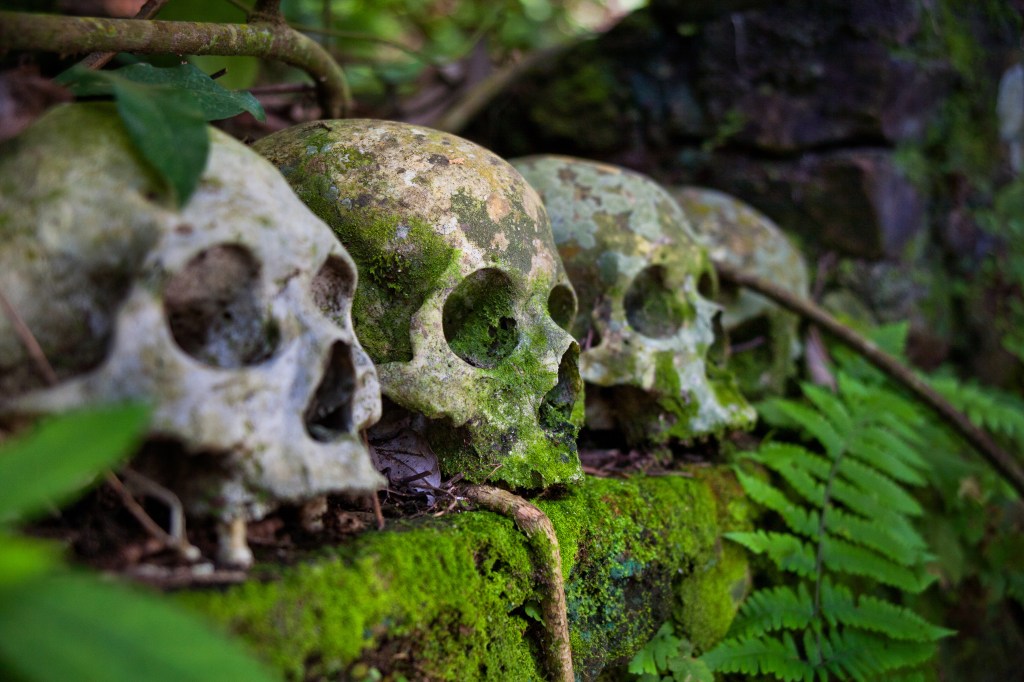
Once the body has decayed, the skull is moved to a nearby rock platform to rest among dozens of others. Make no bones about it, this is a seriously disturbing sight. Think it stinks? Locals give thanks to the banyan tree growing on the sacred spot for squelching the stench. They say the tree, which they consider to be holy, neutralizes the smell of death.
The villagers welcome anyone to attend the burial ritual. It’s only accessible by boat, but heed this warning: Don’t swipe any souvenirs. Natives tell tales of a group of Indonesian tourists whose car plummeted off a cliff after stealing bones from the burial grounds. According to a legend, a Western tourist who took a skull as a keepsake got more than he bargained for. They say he promptly journeyed back to Trunyan to return the skull, claiming it talked at night.
Greyfriars Kirkyard (Scotland)
Bruises, burns, and broken bones! An unpredictable poltergeist causes bodily harm to those who risk a visit to his Gothic graveyard.
Crumbling Angel of Death statues keep watch over Edinburgh’s Greyfriars Kirkyard. Meanwhile, many graves at this 16th-century Scottish cemetery are encapsulated with menacing-looking metal grates, called mortsafes. They were once used to deter body-snatching grave robbers. However, it’s not marauders that you need to worry about. Greyfriars is home to Scotland’s most terrifying paranormal phenomenon: Mackenzie’s Poltergeist.
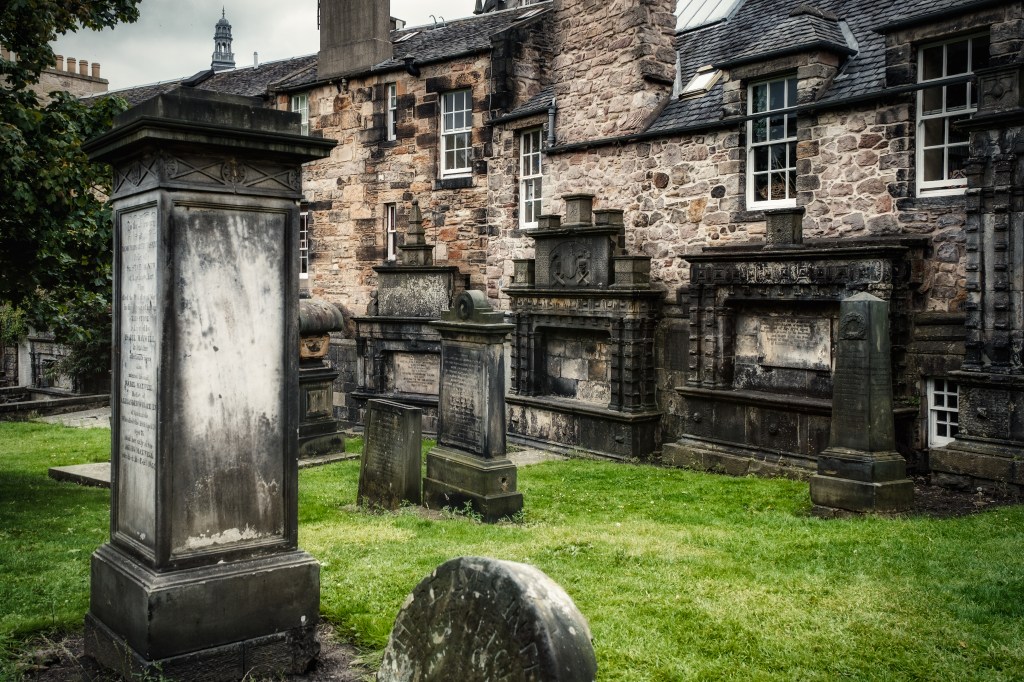
Lawyer and Lord Advocate Sir George “Bloody” Mackenzie earned a reputation for being a cold-hearted persecutor of Scottish Covenanters, who were part of the 17th-century Presbyterian movement. He died in 1691 and was entombed in a domed mausoleum inside Greyfriars Kirkyard. Ironically, he’s alongside many of those Presbyterians he had sentenced to death or imprisoned in a field next to the cemetery, in what is believed to be the world’s first concentration camp.
Mackenzie’s Wrath
Local lore states Mackenzie’s spirit has been on a rampage since it escaped in 1999, after a homeless man, seeking shelter, broke into the mausoleum and fell through the floor. During nighttime visits to the cemetery, explorers report being bruised, burned, and scratched by Mackenzie’s Poltergeist. According to The Scotsman, in 2006, 140 people reported being attacked. Some even suffered broken bones.
Worst of all, the scary spirit is suspected of killing Scottish clairvoyant Colin Grant shortly after he performed an exorcism in front of the church inside Greyfriars Kirkyard in November 1999. The church was locked and empty, yet Susan Burrell, an Edinburgh Evening News photographer, captured an imposing dark figure watching from the window. Two months later, Grant dropped dead from a heart attack while talking to spirits during a séance at his clairvoyant shop. This led many to believe his sudden death was Mackenzie’s Poltergeist exacting his revenge.
Devil’s Chair (Missouri)
Take a seat, if you dare. It’s a one-way trip straight to hell!
Urban legend claims that if a person is fearless — or foolish — enough to sit in the marble monument known as the Devil’s Chair inside Highland Park Cemetery in Kirksville, Missouri at the stroke of midnight or on Halloween, a grotesque undead hand will rise from the grave and drag the occupant down to the unknown horrors of the underworld.

The concrete seat, officially named Baird’s Chair, had a much less sinister start. Following the death of his wife, Anna Maria (Hoye) Baird in 1911, David Baird, a marble and granite dealer, commissioned his business partner to sculpt the monument out of concrete. For his beloved spouse’s grave, he wanted the mourning seat to serve as her tombstone. When David himself died the following year, he was buried alongside Anna Maria.
More than a century later, groups of scare-seekers sneak into the cemetery regularly to tempt fate and taunt whatever demonic forces lurk beneath. According to the book Weird Illinois, the Devil’s Chair legend dates back to the 1800s. It started in the Appalachian Mountains, where there was talk of chairs levitating off the ground in graveyards. They said anyone who sat on the supernatural seat earned the ability to make a pact with the devil. The catch? Satan would eventually return to collect their soul as payment.
Prague Jewish Quarter Cemetery (Czech Republic)
An undead organist plays a haunting tune. It will be your last waltz if you accept a dance with this phantom lady of the night.
Take one look at Europe’s oldest Jewish cemetery, located in the capital city of the Czech Republic, and it is easy to believe that an estimated 100,000 people are buried there. The 12,000 tombstones are tightly packed due to the dead being stacked on top of each other for more than three centuries.
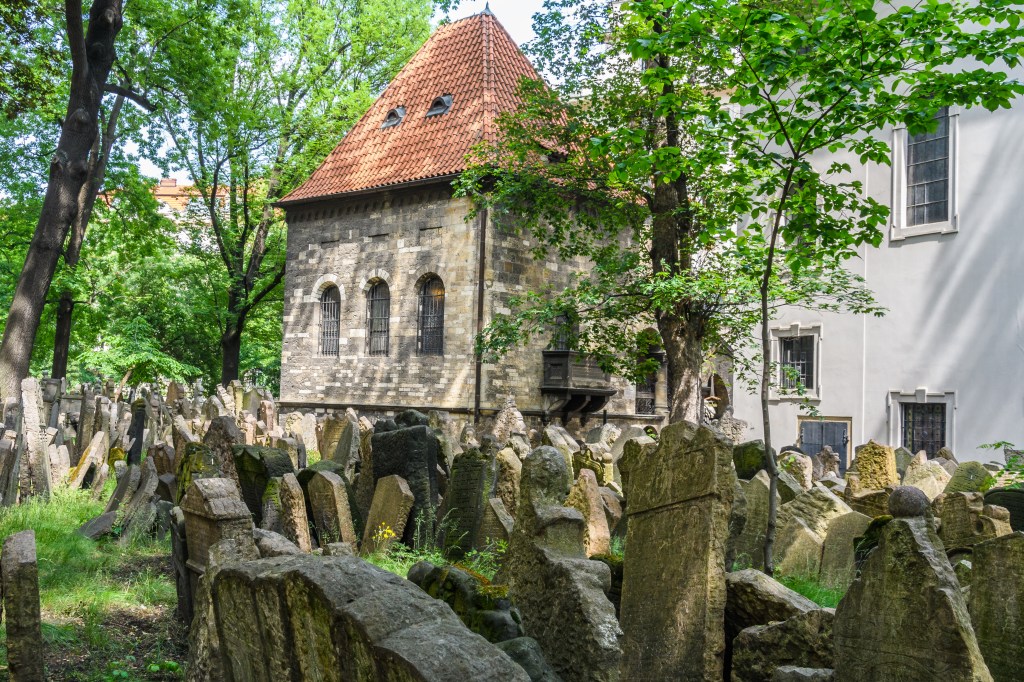
Walking around this final resting place of so many spirits is eerie and disconcerting. The tombstones are toppling over and sit crookedly, like a witch’s sinister smile. The last burial took place here in 1787. However, the place is still quite active today, with spirits said to be escaping their cramped resting places.
The Spirits That Wander
Among the specters is a dangerous ghost known as the Dancing Jewess. She was once a friendly, well-liked prostitute who was tragically beaten bloody by a mysterious man who cursed her to “dance until Judgment Day.” According to local lore, she’s still walking the streets of Prague looking for the next victim to join her in a dance to the death.
At 11 o’clock each night, the ghost of a former organist, who converted from Judaism to Christianity before returning to be buried at the sacred Jewish site, rises from his grave. As if that’s not creepy enough, the restless musician has a skeleton companion that transports him to St. Vitus Cathedral via boat. Once there, he plays the organ as his skeleton cohort works the bellows, before the pair make their journey back to the graveyard at 1 a.m.
Also, watch your neck around the Strangling Jewess. She is the ghost of a young woman who went insane after her love affair with a monk was uncovered, and he was banished to a remote monastery. Every night, she returned to the secret spot of their forbidden love, wailing for her beloved. One night her anguished cries caught the attention of an abbot. When he went to check on her, she strangled him. Now her vengeful spirit still appears in that location, looking for her next victim.
Westminster Hall Catacombs (Maryland)
Beware: a screaming skull drives men mad. Could that explain why the vision of macabre writer Edgar Allen Poe paces this creepy graveyard evermore?
The eerie catacombs of this Baltimore burial ground were created in 1852 when brick piers were built above the cemetery’s graves to allow for the construction of Westminster Presbyterian Church. Edgar Allan Poe, author of The Tell-Tale Heart and The Raven, is one of the most notorious souls buried here. He died days after being discovered delirious and in distress, wandering the streets. The Baltimore Health Commissioner listed Poe’s cause of death as “congestion of the brain,” and he was laid to rest in a small, unmarked grave. But that wasn’t the end of his story.
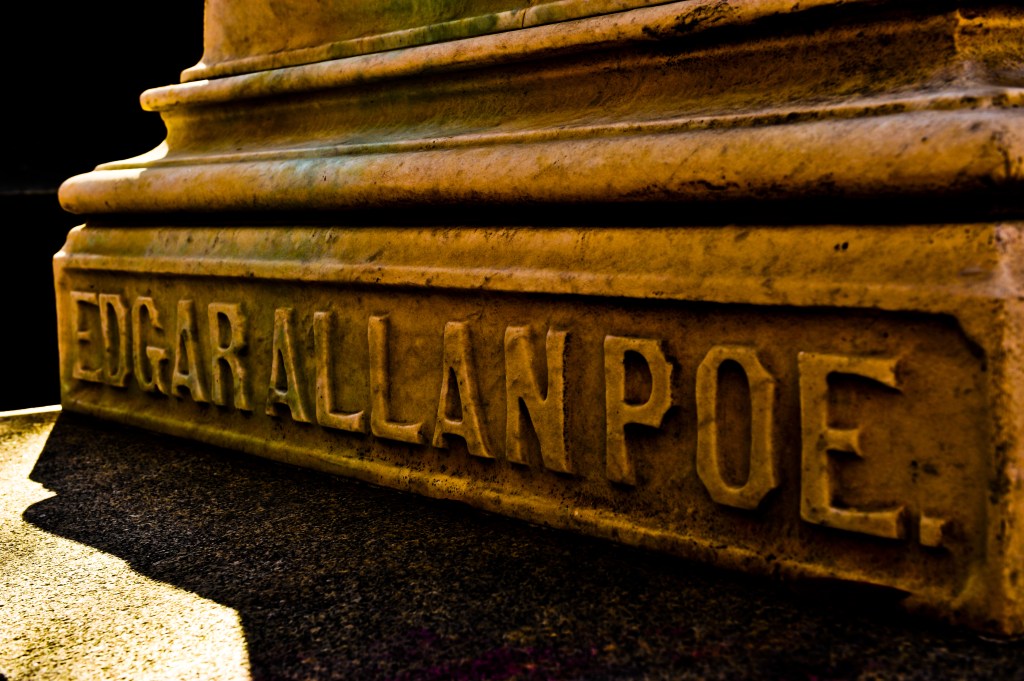
Two decades after Poe’s mysterious death, his remains were dug up from the original site in the south end of the cemetery. They were again laid to rest along with his wife, Virginia, and mother-in-law, Maria Clemm. That spot is marked with a stately marble monument, much more befitting the famous American writer, in the northwest corner of the graveyard. However, the disturbance seems to have awakened the poet’s spirit. For decades, people have reported seeing a phantom Poe wandering his grave site, pausing at the altar inside Westminster Hall.
Gallivanting Ghosts
Poe is not the only spook in Westminster. Visitors have seen the apparition of 16-year-old Lucia Watson Taylor, dressed in white, praying over her own grave. More disturbing is the ghost of the grave-robbing medical school student who met his end hanging from a nearby streetlight. He’s still searching the catacombs. The cemetery’s Skull of Cambridge is truly terrifying, like something from one of Poe’s stories. It’s believed to be the decapitated head of a murdered minister. It ended up being encased in cement and buried to contain the sound of its screams. Legend has it that the bloodcurdling cries of the minister linger in the mind of listeners until they go mad.
Hanging Coffins of Sagada (Philippines)
Welcome to a nightmare: Corpses dangle from cliffs and caves at this gravity-defying graveyard.
The people of the Igorot tribe on Luzon Island in the mountain province of Sagada in the Philippines don’t bury their dead underground; they hang them. The elders of the community carve their own coffins from hollow logs and paint their names on the side as part of this unique ritual.
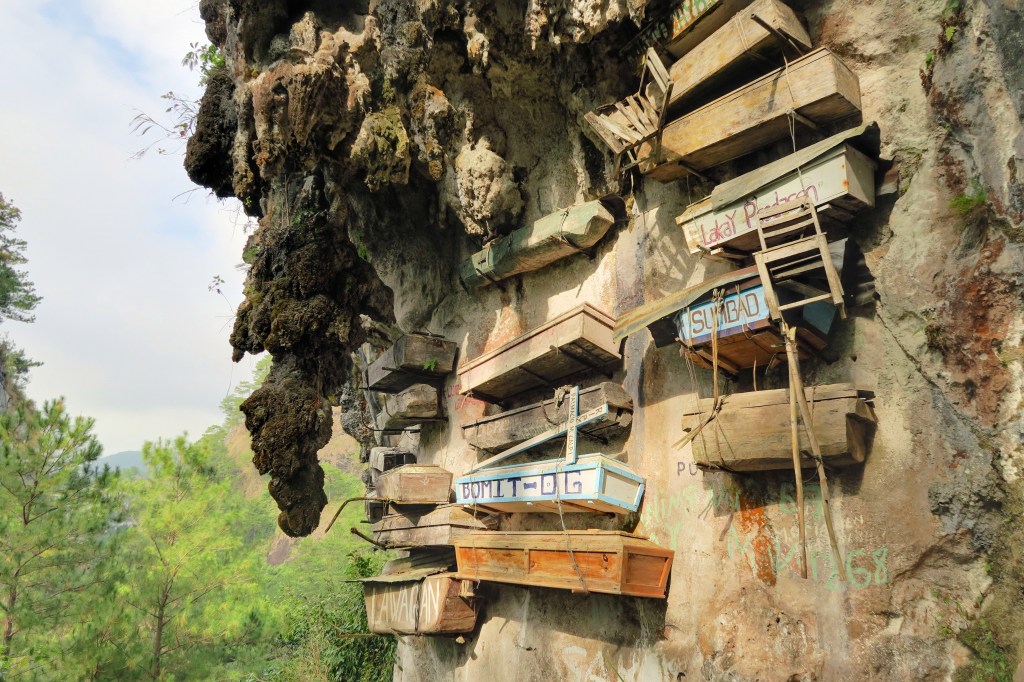
After death, a corpse is seated in a wooden “death chair.” Then, the lifeless body is bound with vines and leaves before being draped with a blanket and placed near a ceremonial fire. Finally, the tribe uses smoke to preserve the corpse before it is deposited into its coffin in the fetal position. This can be a brutal process that often involves breaking their bones.
Then, instead of being lowered into a grave, the handmade coffins are either hoisted and nailed to the walls of caves, or hung off a cliff face. The Igorot people have been dealing with their dead in this manner, which they believe brings them closer to their ancestral spirits, for more than 2,000 years. As a result, some of the still-hanging, hand-carved caskets are at least a century old. Eventually, each one deteriorates and plunges to the ground. This is why lionhearted tourists are instructed to never stand beneath the coffins or touch them. It’s out of respect for the dead, as well as for their own personal safety.
Salem Church Cemetery (Ohio)
Shadowy figures, ominous knocking, and the specters of Civil War soldiers make this one of America’s most haunted places.
A ghastly Civil War sentinel is said to stand guard over this Salem, Ohio, cemetery dating back to the 1800s. Many soldiers died in the bloody Morgan’s Raid, the most extensive Confederate invasion in Ohio, which took place nearby. Since the 1870s, lore suggests spooky uniformed specters keep eternal watch over their fallen brothers-in-arms.
Long before the land was a graveyard, an evil high priestess was believed to have been killed and buried there. Hundreds of visitors have reported terrifying run-ins with the dark witch with icy hands. Paranormal investigators with electronic voice phenomena (EVP) recorders and infrared cameras have caught unexplainable, eerie sounds, floating orbs, and shadowy figures.
It comes as no surprise that the cemetery struggles to hold onto its caretakers. The ghostly guests and residents are said to give them a never-ending fright. Mystified workers report that ancient statues vanish and reappear days later, and weathered tombstones shift positions. Local legend has it that those brave enough to knock on the vaulted doors of the adjacent church will hear three phantom knocks repeated back from deep inside the historical house of prayer. Meanwhile, a dark figure has been spotted lurking behind the church. At night, you might hear the tormented cries of Louiza Fox ringing out across the graveyard. The 13-year-old had her throat slit by her jilted ex-fiancé, Thomas Carr, in 1869. She has been seen wandering near her grave. Carr, who confessed to killing her and 14 others and was hanged, has also been spotted at the cemetery.
St. Louis Cemetery No. 1 (Louisiana)
Heed the violent voodoo queen and a sailor seeking his final resting spot.
The crumbling aboveground crypts are just one reason why author Mark Twain once called New Orleans’ graveyards “the Cities of the Dead.” Considering there are more than 100,000 people laid to rest at the city’s St. Louis Cemetery No. 1, he nailed it. Many of those dead are still very active inside the cemetery walls. The most famous resident is the Voodoo Queen, Marie Laveau. Disembodied voices have been heard coming from deep inside her tomb. Those who have caught a ghastly glimpse of her red-and-white turban and colorful clothes report being scratched, pushed, pinched, and knocked to the ground by the phantom. She is also credited with causing visitors to become suddenly and unexplainably sick.
Lost Souls
Henry Vignes was a 19th-century sailor who made a local boardinghouse his home. The owner of the boarding house, who was in possession of Vignes’ important papers, including the deeds to his family crypt in St. Louis Cemetery, sold the tomb while he was out to sea. This didn’t sit right with the sailor. He died shortly after his return, and was buried in an unmarked grave in the paupers’ section. This could explain why his ghost asks tourists to help him find his grave. His spirit has been caught on camera, and an EVP has recorded a man’s voice declaring, “I need to rest!”
Alphonse is another lost soul at the graveyard. First, his specter takes flowers from any of the 700 tombs packed into the cemetery to decorate his own memorial. Then, the ghostly Alphonse grabs guests’ hands and asks if they can bring him home. While no one knows if foul play was involved in his death, the spirit warns visitors to stay away from the Pinead family tomb if they get too close.
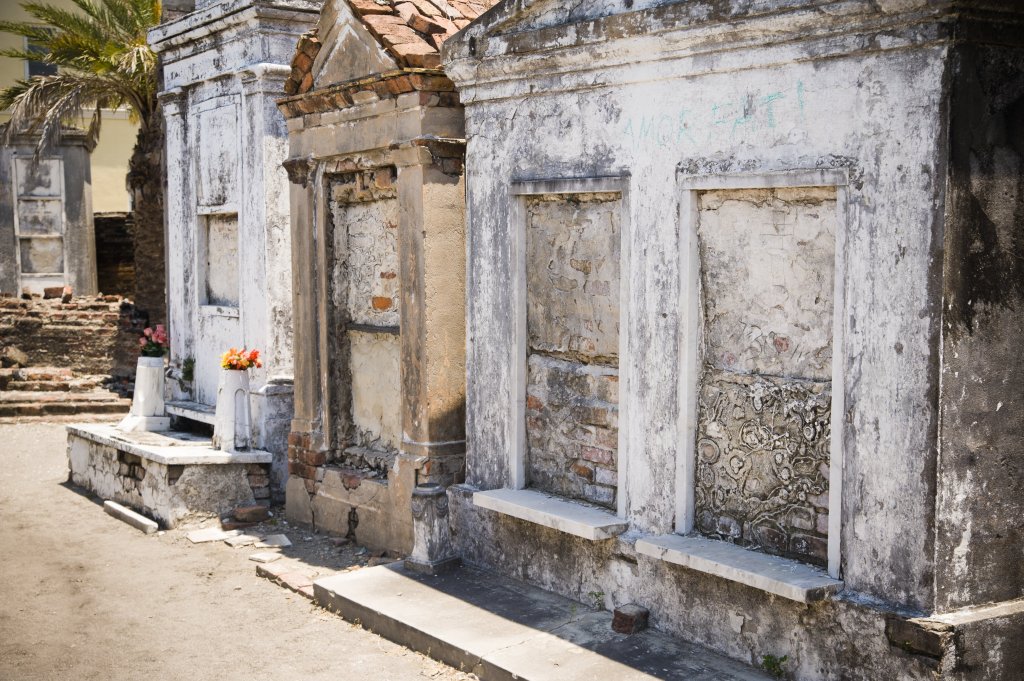
Catacombs of Paris (France)
After midnight, the walls start talking in this bone-chilling labyrinth under the streets of the French capital.
Is that voices you hear beneath the streets of Paris? Very possibly. The remains of more than 6 million people are packed into the miles of tunnels that run under the city. The Catacombs are a maze of former limestone quarries, dating back to Gallo-Roman times. They were turned into a bone-yard once the city’s cemeteries became too full in the late 18th century.
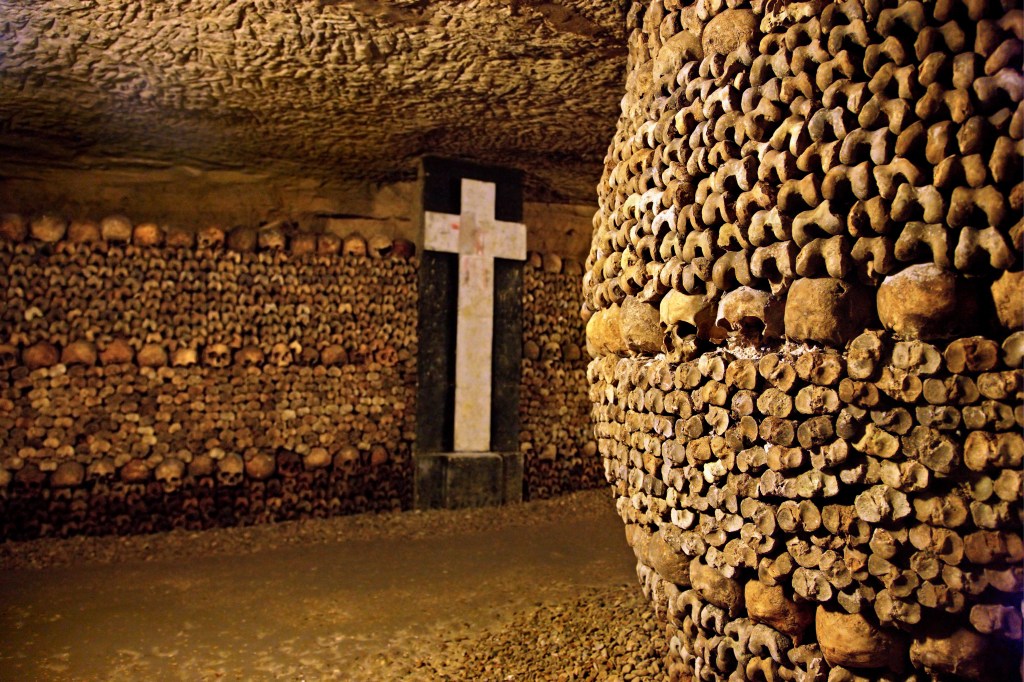
A Terrifying Tomb
A small fragment of the dank, dark space has been open to the public since July 1, 1809. In order to get there, visitors must descend 65 feet down a steep spiral staircase, only to be greeted with the following warning: STOP: This is the Empire of Death. You may find yourself battling with feelings of claustrophobia as you descend deeper into the silent, bone-lined tunnels.
You might also bump into the unofficial patron saint of the Catacombs: the ghost of Philibert Aspairt. He was a doorman at the Val-de-Grâce hospital, who accidentally wandered into the tunnels while fetching a bottle of booze on November 3, 1793. Aspairt got lost, and his body was only discovered and identified 11 years later. A memorial was then erected at the site. Some say his spirit returns every year, on the anniversary of his disappearance, to haunt the halls. The bones are eerily arranged in artistic patterns and used as decorations around small rooms and vaults.
Legend has it that the walls come alive after midnight with whispers coming from the skulls, so you want to be long gone before then. Yet, not all the remains down there are human. In 1896, hundreds of cat skulls were also found in the tunnels. It turns out the tunnel shared a well with a restaurant where the owner was feeding diners feline meat instead of the rabbit they requested!













